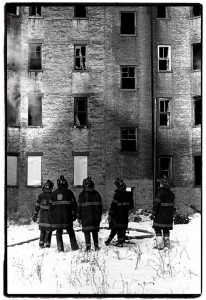Harvey Wang’s Portraits of a Vanished NY at the Tenement Museum
Siegfried Liebman, mannequin maker; Eddie Day, brakeman on the Cyclone at Coney Island; Helen Giamanco, salad maker, Horn & Hardart Automat; Joe Baffir, boxing trainer; Julius Hans, tailor of rabbinical robes; Veronica Parker Johns, owner, Seashells Unlimited, a Third Avenue Manhattan store; and David Turnowsky, counterman at Katz’s Deli–these are just some of the New Yorkers who Harvey Wang has photographed since he began taking pictures more than three decades ago. I was really excited this past Wednesday to attend the reception for “Out Harvey Wang’s Window,” a retrospective of his work at the Lower East Side Tenement Museum‘s new space at 103 Orchard Street. I urge to go see this terrific exhibit.

I first learned of Wang’s distinctive work from his 1990 book Harvey Wang’s New York, which included a photograph of diarist Edward Robb Ellis–whose books A Diary of the Century and The Epic of New York City I would later have the privilege of publishing. 
 In a Foreword to Wang’s book, Pete Hamill eloquently observes that the photographer celebrates “the New York of work and endurance. In this New York, human beings are driven by pride, not vanity. They have pride in craft and skill, in their abilities to do difficult tasks better than others.”
In a Foreword to Wang’s book, Pete Hamill eloquently observes that the photographer celebrates “the New York of work and endurance. In this New York, human beings are driven by pride, not vanity. They have pride in craft and skill, in their abilities to do difficult tasks better than others.”
In the New York Times Lens blog and slideshow on the exhibit, reporter Sam Dolnick notes it was 1979 when Harvey moved into a fifth-floor walkup in Chinatown and “an easy bike ride from the East Village Clubs where he took pictures of strobe-lit dance floors and bohemian debauchery–and besides, rent was only $140 a month. But as he settled into his new neighborhood, he found other subjects that seized his imagination.” These included Turnowsky at Katz’s, “dwarfed by a towering wall” of salamis and a pillow maker who worried about competing with department stores, concluding, “This is a hard business.” Dolnick observed that Harvey “had found a new muse,” who said “’I wanted to capture these businesses before they went away. It was a hinge moment.’” 



It was heartening to see Harvey’s work exhibited on the Lower East Side where he discovered his muse more than thirty years ago, though it also prompted a reflection that the shops and craftworkers that gave the neighborhood its character have disappeared. I’m thankful that Harvey was there to record it.




Leave a Reply
Want to join the discussion?Feel free to contribute!